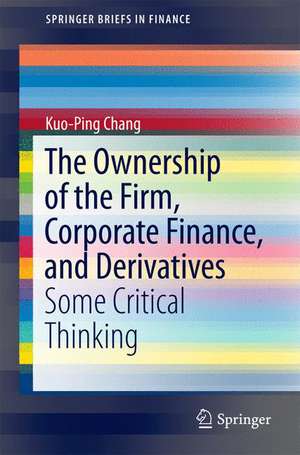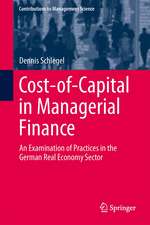The Ownership of the Firm, Corporate Finance, and Derivatives: Some Critical Thinking: SpringerBriefs in Finance
Autor Kuo-Ping Changen Limba Engleză Paperback – 16 ian 2015
Din seria SpringerBriefs in Finance
-
 Preț: 354.10 lei
Preț: 354.10 lei - 17%
 Preț: 359.35 lei
Preț: 359.35 lei -
 Preț: 374.85 lei
Preț: 374.85 lei -
 Preț: 346.01 lei
Preț: 346.01 lei -
 Preț: 341.75 lei
Preț: 341.75 lei -
 Preț: 379.09 lei
Preț: 379.09 lei -
 Preț: 375.62 lei
Preț: 375.62 lei -
 Preț: 381.18 lei
Preț: 381.18 lei -
 Preț: 377.73 lei
Preț: 377.73 lei -
 Preț: 376.80 lei
Preț: 376.80 lei -
 Preț: 377.18 lei
Preț: 377.18 lei -
 Preț: 476.95 lei
Preț: 476.95 lei -
 Preț: 377.95 lei
Preț: 377.95 lei -
 Preț: 444.35 lei
Preț: 444.35 lei -
 Preț: 477.34 lei
Preț: 477.34 lei -
 Preț: 410.94 lei
Preț: 410.94 lei -
 Preț: 376.22 lei
Preț: 376.22 lei -
 Preț: 376.43 lei
Preț: 376.43 lei -
 Preț: 489.30 lei
Preț: 489.30 lei -
 Preț: 441.85 lei
Preț: 441.85 lei -
 Preț: 375.45 lei
Preț: 375.45 lei -
 Preț: 381.21 lei
Preț: 381.21 lei -
 Preț: 308.44 lei
Preț: 308.44 lei -
 Preț: 344.14 lei
Preț: 344.14 lei -
 Preț: 345.89 lei
Preț: 345.89 lei -
 Preț: 376.04 lei
Preț: 376.04 lei -
 Preț: 407.67 lei
Preț: 407.67 lei -
 Preț: 410.55 lei
Preț: 410.55 lei -
 Preț: 378.92 lei
Preț: 378.92 lei - 15%
 Preț: 461.40 lei
Preț: 461.40 lei
Preț: 376.22 lei
Nou
Puncte Express: 564
Preț estimativ în valută:
71.99€ • 76.98$ • 60.02£
71.99€ • 76.98$ • 60.02£
Carte tipărită la comandă
Livrare economică 18 aprilie-02 mai
Preluare comenzi: 021 569.72.76
Specificații
ISBN-13: 9789812873521
ISBN-10: 981287352X
Pagini: 92
Ilustrații: XII, 76 p. 11 illus.
Dimensiuni: 155 x 235 x 10 mm
Greutate: 0.14 kg
Ediția:2015
Editura: Springer Nature Singapore
Colecția Springer
Seria SpringerBriefs in Finance
Locul publicării:Singapore, Singapore
ISBN-10: 981287352X
Pagini: 92
Ilustrații: XII, 76 p. 11 illus.
Dimensiuni: 155 x 235 x 10 mm
Greutate: 0.14 kg
Ediția:2015
Editura: Springer Nature Singapore
Colecția Springer
Seria SpringerBriefs in Finance
Locul publicării:Singapore, Singapore
Public țintă
ResearchCuprins
Preface.- Chapter 1: The Ownership of the Firm.- 1.1: A Story of Robin Hood.- 1.2: Power, Entrepreneur, and Objectives of the Firm.- 1.3: Choice, Risk Attitude, and Types of Contract.- References.- Chapter 2: Maximizing Profits and Maximizing Resource Providers’ Wealth.- 2.1: The Coase Theorem and the Modigliani-Miller Propositions.- 2.2: A Simple Example of the Modigliani-Miller Second Proposition.- References.- Chapter 3: A Reconsideration of the Modigliani-Miller Propositions.- 3.1: A Tale of Two Cows-The Modigliani-Miller First Proposition.- 3.2: Some Fallacious Arguments for the Modigliani-Miller Second Proposition.- References.- Chapter 4: Derivatives and the Theory of the Firm.- 4.1: Model-Free Option Prices.- 4.2: The Firm’s Resources and Derivatives.- 4.2.1: Each Resource Is Both a European Call Option and a European Put Option.- 4.2.2: Each Resource Is a Stock Plus a Forward Contract.- References.- Chapter 5: Arbitrage and Valuation of Different Contracts.- 5.1: The Arbitrage Theorem.- 5.2: Properties of the Binomial Option Pricing Model.- 5.3: Valuing Different Contracts.- Appendix A: Incomplete Market.- Appendix B: Incomplete Market and Replication of Securities.- Appendix C: More Uncertain Project and the Firm’s Value.- References.- Chapter 6: Misinterpretations of Residual Claim in Finance and Corporate Law.- 6.1: De Jure versus De Facto.- 6.2: Agency Costs and Residual Claim.- 6.3: Moral Hazard and Residual Claim.- References.- Index.
Notă biografică
Dr. Chang is Honourable Emeritus Professor, Department of Quantitative Finance at National Tsing Hua University, Taipei, Taiwan. He received his PhD degree in Economics & Finance from University of Pennsylvania, USA. Dr. Chang has been teaching microeconomics, mathematical economics, and mathematical finance in both economics and finance departments for many years. He has published various papers in leading journals of management science, economics and finance regarding productivity/efficiency analysis, regulatory economics, and quantitative finance.
Caracteristici
Clarifies several ambiguous arguments and claims in finance and the theory of the firm Serves as a bridge between derivatives, corporate finance and the theory of the firm Uses anecdotes and numerical examples to explain some unconventional concepts Includes supplementary material: sn.pub/extras












